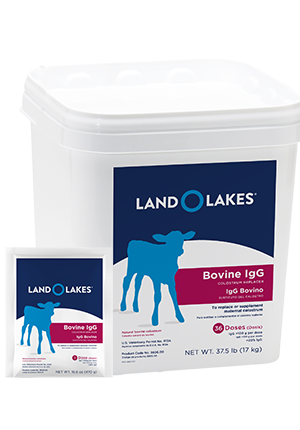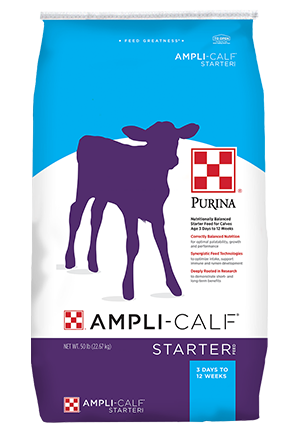
Four Questions to Ask About Calf Colostrum Replacer
Calf : Calf Nutrition

Everyone knows providing a newborn calf with colostrum within 12 hours of birth is vital. But, what should you do when cow colostrum is unavailable?
A quality calf colostrum replacer can provide a healthy alternative.
The next question is, what type of calf colostrum replacer should you purchase? It’s common to purchase by price point, but a product selected on price may not give a newborn calf the start it needs.
Here are a few questions to ask before purchasing a calf colostrum replacer:
A colostrum supplement, on the other hand, is designed to be fed in conjunction with colostrum collected on-farm. It can be used to boost quality when colostrum quality is less than ideal. Depending on your situation, both options provide different benefits.
With serum products, collected blood is the source of antibodies for the calf. These products can be effective in transferring immunity to the calf, but they can be short on soluble factors and maternal cells. The newborn calf depends on these for immunity until it’s immune system starts working.
Studies showed greater feed efficiency through 30 days of age when calves were fed bovine colostrum instead of a serum-based replacer.1
Globulin proteins include a variety of other proteins in addition to the IgG antibodies. It’s nearly impossible to know what percentage of globulin protein is IgG by looking at the package. So, a product could be labeled as providing 130 grams of globulin protein but may contain much less than the crucial 100 grams of IgG calves need for adequate immunity.
Don’t let the number on the package be the deciding factor in your buying decision unless the number guarantees a specific IgG level.
By purchasing a calf colostrum replacer that is USDA-licensed, you can better ensure calves are getting the crucial energy and antibodies they need in the first 12 hours of life.
With LAND O LAKES® Colostrum Replacement, you can easily meet all the requirements. This calf colostrum replacer is made from natural bovine colostrum to help achieve successful passive transfer. It also helps you deliver 100 grams or more (or more?) of IgG in 16.6 oz of powder in this single dose replacement for maternal colostrum.
When it comes to calf colostrum replacers, your decision is an important one because you only get one chance to start a calf off on the right foot (or in this case hoof).
What comes after the first 24 hours? Make sure your milk replacer, starter and grower are providing the best nutrition for your calves. Learn more here.
1C.M. Jones, R.E. James, J.D. Quigley, III, and M.L. Gilliard. Influence of Pooled Colostrum or Colostrum Replacement on IgG and Evaluation of Animal Plasma in Milk Replacer, Journal of Dairy Science, Volume 87, Pages 1806-1814, 2004.
A quality calf colostrum replacer can provide a healthy alternative.
The next question is, what type of calf colostrum replacer should you purchase? It’s common to purchase by price point, but a product selected on price may not give a newborn calf the start it needs.
Here are a few questions to ask before purchasing a calf colostrum replacer:
1. Is it a calf colostrum replacer or a colostrum supplement?
Although very similar, it’s important to note the difference between a calf colostrum replacer and a colostrum supplement. A calf colostrum replacer is designed to be fed as the calf’s only source of colostrum. It’s most commonly used when high-quality colostrum is not available – for example, if a cow tests positive for Johne’s disease.A colostrum supplement, on the other hand, is designed to be fed in conjunction with colostrum collected on-farm. It can be used to boost quality when colostrum quality is less than ideal. Depending on your situation, both options provide different benefits.
2. Is the product made from real bovine colostrum or blood serum?
Products listed as “real colostrum” are just that. They contain colostrum collected from dairy cows. The colostrum has been dried down and heat-treated to eliminate any harmful agents like Johne’s disease or mycoplasma.With serum products, collected blood is the source of antibodies for the calf. These products can be effective in transferring immunity to the calf, but they can be short on soluble factors and maternal cells. The newborn calf depends on these for immunity until it’s immune system starts working.
Studies showed greater feed efficiency through 30 days of age when calves were fed bovine colostrum instead of a serum-based replacer.1
3. Is the calf colostrum replacer labeled with a claim for Bovine Immunoglobulins (IgGs) or just globulin proteins?
IgGs are the antibodies that protect calves from pathogens which may cause scours and respiratory diseases.Globulin proteins include a variety of other proteins in addition to the IgG antibodies. It’s nearly impossible to know what percentage of globulin protein is IgG by looking at the package. So, a product could be labeled as providing 130 grams of globulin protein but may contain much less than the crucial 100 grams of IgG calves need for adequate immunity.
Don’t let the number on the package be the deciding factor in your buying decision unless the number guarantees a specific IgG level.
4. Is the calf colostrum replacer licensed by the USDA as a total replacement for maternal colostrum?
There is no way of guaranteeing the potency or effectiveness of a product unless it’s licensed by the USDA. Some serum-based replacers will use blood from USDA-certified meat processors, but the replacer product containing this blood has never been tested by the USDA for effectiveness in transferring immunity to calves.By purchasing a calf colostrum replacer that is USDA-licensed, you can better ensure calves are getting the crucial energy and antibodies they need in the first 12 hours of life.
The bottom line?
All calf colostrum replacers are not created equal. Pay close attention to details, read the label carefully and ask questions when selecting the best calf colostrum replacer product for your operation.With LAND O LAKES® Colostrum Replacement, you can easily meet all the requirements. This calf colostrum replacer is made from natural bovine colostrum to help achieve successful passive transfer. It also helps you deliver 100 grams or more (or more?) of IgG in 16.6 oz of powder in this single dose replacement for maternal colostrum.
When it comes to calf colostrum replacers, your decision is an important one because you only get one chance to start a calf off on the right foot (or in this case hoof).
What comes after the first 24 hours? Make sure your milk replacer, starter and grower are providing the best nutrition for your calves. Learn more here.
1C.M. Jones, R.E. James, J.D. Quigley, III, and M.L. Gilliard. Influence of Pooled Colostrum or Colostrum Replacement on IgG and Evaluation of Animal Plasma in Milk Replacer, Journal of Dairy Science, Volume 87, Pages 1806-1814, 2004.


